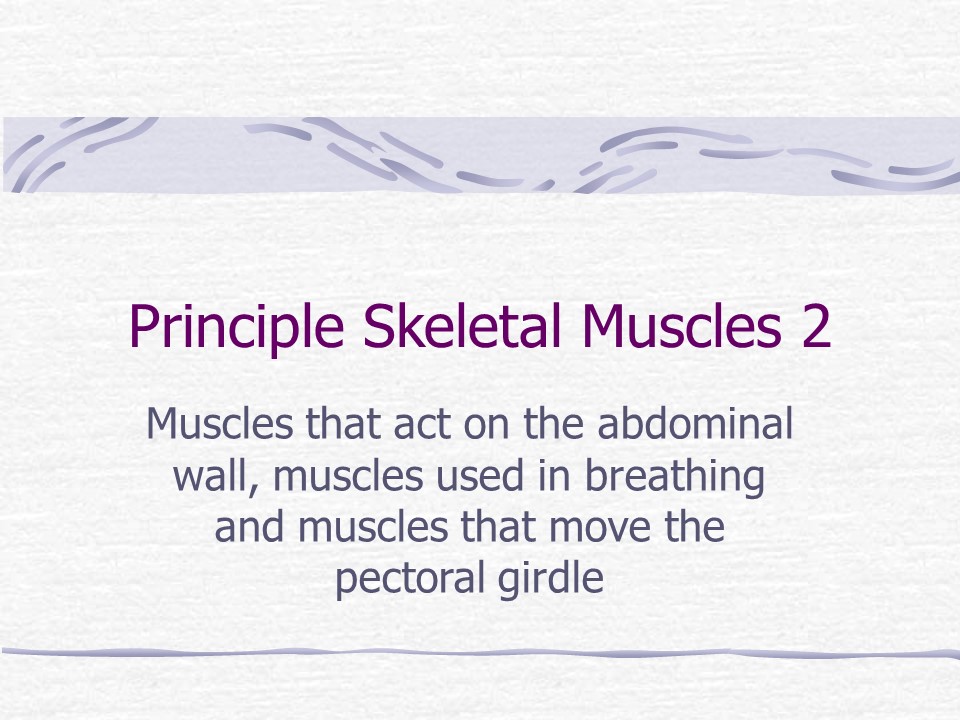Principle Skeletal Muscles 2 - PowerPoint PPT Presentation
1 / 25
Title:
Principle Skeletal Muscles 2
Description:
Principle Skeletal Muscles 2 Muscles that act on the abdominal wall, muscles used in breathing and muscles that move the pectoral girdle MUSCLES THAT ACT ON THE ... – PowerPoint PPT presentation
Number of Views:108
Avg rating:3.0/5.0
Title: Principle Skeletal Muscles 2
1
Principle Skeletal Muscles 2
- Muscles that act on the abdominal wall, muscles
used in breathing and muscles that move the
pectoral girdle
2
MUSCLES THAT ACT ON THE ANTERIOR ABDOMINAL WALL
- The anterior abdominal wall is composed of skin,
fascia and 4 pairs of muscles. - Tendinous Intersections bands of connective
tissue that divides the rectus abdominis - Linea Alba tough fibrous band extending from
xiphoid process to pubic symphysis
3
Rectus Abdominis
- Origin Pubis and Pubic Symphysis
- Insertion Costal Cartilage and Xiphoid Process
- Action Flexes vertebral column and compresses
abdomen
4
Linea Alba
Tendinous Intersections
5
External Oblique
- Origin Lower 8 ribs
- Insertion Crest of Ilium and Linea Alba
- Action Compresses abdomen, flexes vertebral
column. Singularly rotates vertebral column
6
(No Transcript)
7
Internal Oblique
- Origin Ilium, inguinal ligament
- Insertion Costal Cartilage and linea alba
- Action - Compresses abdomen, flexes vertebral
column. Singularly rotates vertebral column
8
(No Transcript)
9
Transverse Abdominis
- Origin Ilium, inguinal ligament, lumbar fascia,
and costal cartilage - Insertion Xiphoid Process, linea alba and pubis
- Action Compress Abdomen
10
(No Transcript)
11
(No Transcript)
12
Muscles Used in Breathing
- These muscles alter the size of the thoracic
cavity so that breathing can occur. Inhalation
occurs when the thoracic cavity increases in size
and exhalation occurs when the thoracic cavity
decreases in size
13
Diaphragm
- Origin xiphoid process, costal cartilage and
lumbar vertebrae - Insertion central tendon
- Action increases the vertical dimension of the
thoracic cavity resulting in inhalation.
14
(No Transcript)
15
External and Internal Intercostals
- Origin ribs
- Insertion ribs
- Action
- External increases the anteroposterior and
lateral dimensions of thoracic cage resulting in
inhalation - Internal decreases the antroposterior and
lateral dimensions resulting in forceful
exhalation
16
(No Transcript)
17
Muscles that Move the Pectoral Girdle
- These muscles are divided into anterior
(pectoralis minor and serratus anterior) and
posterior (trapezius, levator scapulae and
rhomboid major) thoracic muscles based on their
location. - The main action of the muscles is to hold the
scapula in place so that is can function as a
stable origin for the muscles that move the
humerus
18
Pectoralis minor
- Origin Ribs 3-5
- Insertion Scapula
- Action depresses scapula, moves it laterally
and forward
19
(No Transcript)
20
Serratus Anterior
- Origin Upper 8 or 9 ribs
- Insertion Scapula
- Action Moves scapula laterally and forward.
- AKA the boxers muscle because it is important
in horizontal arm movements like punching.
21
(No Transcript)
22
Trapezius
- Origin occipital bone, spines of C7 and
thoracic vertebrae - Insertion clavicle and scapula
- Action Elevates clavicle, moves scapula medially
23
(No Transcript)
24
Levator Scapulae
- Origin C1 C5
- Insertion Scapula
- Action elevates scapula
25
Rhomboid Major
- Origin Spines of T2-T5
- Insertion Scapula
- Action Elevates scapula, moves it medially

